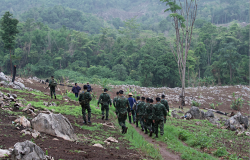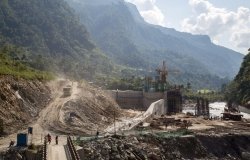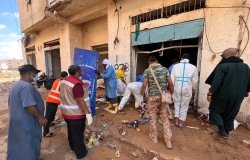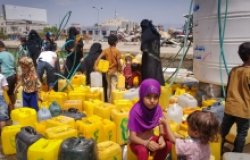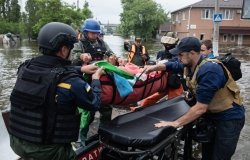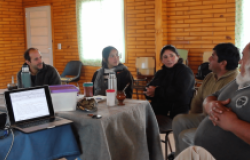Environment is "Peace Policy of the 21st Century," Says UNEP's <i>Africa Environment Outlook 2</i>
JANUARY 2007--New Report Promotes Development Through Environmental Cooperation
 Africa's economic growth and development are inextricably linked to the region's environmental wealth and human well-being. But despite its natural resource endowment, Africa is the poorest continent in the world—and remains wracked by deadly conflicts. A new comprehensive assessment by the United Nations Environment Programme (UNEP) finds enormous opportunities for African countries to capitalize on their environmental wealth. By leveraging existing cooperative institutions and sustainably managing their natural assets, they may begin to realize not only their development goals, but also their hopes for peace.
Africa's economic growth and development are inextricably linked to the region's environmental wealth and human well-being. But despite its natural resource endowment, Africa is the poorest continent in the world—and remains wracked by deadly conflicts. A new comprehensive assessment by the United Nations Environment Programme (UNEP) finds enormous opportunities for African countries to capitalize on their environmental wealth. By leveraging existing cooperative institutions and sustainably managing their natural assets, they may begin to realize not only their development goals, but also their hopes for peace.
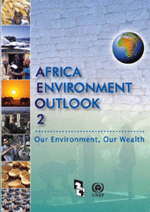 Africa Environment Outlook—Our Environment, Our Wealth (AEO-2) reports that poverty, weak institutions, persistent conflict, and natural resource mismanagement have degraded the environment and handicapped development. The report argues, however, that joint management of transboundary environmental problems and resources could build cooperation among political entities and civil society. UNEP's Executive Director Achim Steiner calls this green path "the peace policy of the 21st century" (p. xxiii).
Africa Environment Outlook—Our Environment, Our Wealth (AEO-2) reports that poverty, weak institutions, persistent conflict, and natural resource mismanagement have degraded the environment and handicapped development. The report argues, however, that joint management of transboundary environmental problems and resources could build cooperation among political entities and civil society. UNEP's Executive Director Achim Steiner calls this green path "the peace policy of the 21st century" (p. xxiii).
Conflict and the Environment
Conflict impairs economic growth, sustainable development, and livelihoods. Since 1970, the report notes, "more than 30 wars have been fought in Africa, seriously undermining regional efforts to ensure long-term stability, prosperity, and peace" (p. 375). Conflict in Africa is often rooted in historical legacies, as groups jockey for land, resources, and political power. Liberia's 14-year civil war illustrates the way a natural resource—timber—can be exploited to fuel a corrupt political regime. Another example is increased conflict in the Darfur region of Sudan, where "creeping desertification, unstable access to land and water, deforestation and local environmental governance" have increased competition for valuable resources (p. 389).
Armed conflict accelerates the loss of infrastructure and degradation of resources, and reduces society's capacity for self-reliance. Diminished access to resources, on which many people base their livelihoods, compromises stability, disrupts social structures, and can lead to food insecurity, says the report: "Areas affected by conflict suffer annual [food production] losses of more than 12 percent" (p. 387). Conflict also uproots people from their homes and resources, more every year: "In 2004, there were almost 2.9 million officially registered refugees in Africa. By 2005, this number had risen to 4.9 million" (p. 509).
Combining Environmental and Economic Goals
Cooperation through existing economic partnerships and environmental agreements can forge peace and foster development, according to UNEP: "It is becoming increasingly common to address sustainable development and environmental management in conjunction with other issues during peace negotiation processes" (p. 403).
African countries have formed many regional and sub-regional cooperative institutions since the end of the colonial era. While regional economic communities are usually created to increase economic development, they also "reinforce sovereign equality, peace and security, democracy and the rule of law, and peaceful settlement of disputes" (p. 380). Institutions such as the African Union, formed in 2002, integrate social, political, and economic issues to help African countries more effectively enter the global economy.
Environment-based cooperative agreements such as the African Ministerial Conference on the Environment "mobilize political and technical support to address diverse environmental issues, such as land degradation and desertification, access to safe drinking water, and integrated water resource management" (p. 378).
Models of Environmental Cooperation
Africa holds the second-largest number of river basins in the world; and joint management treaties and agreements around the region's natural water resources provide good lessons for building cooperative frameworks. AEO-2 cites the Nile Basin Initiative (NBI) as a prime example of building "transnational communities of scientists, civil society organizations, and other stakeholders" (p. 383). The NBI has sought to build trust by sharing scientific information and negotiating equitable use of the Nile River by its 10 riparian countries. The decision-making body developed under this agreement encourages cooperation, targets poverty eradication, and fosters economic integration. (Also see Patricia Kameri-Mbote's recent policy brief, "Water, Conflict, and Cooperation: Lessons From the Nile River Basin").
Just as water resources may build transboundary cooperation, wildlife and biodiversity management hold the same potential to build capacity for sustainable economic growth. AEO-2 highlights several cooperative parks and partnerships including the Ai-Ais/Richtersveld Transfrontier Park between South Africa and Namibia; Great Limpopo Transfrontier Park connecting South Africa, Mozambique, and Zimbabwe; and the Congo Basin Forest Partnership in Central Africa, which comprises some 30 international governmental and non-governmental organizations. The Congo basin forest, UNEP observes, is "the second-largest forest in the world and plays an important role in climate regulation, as well as being a huge repository of biological diversity"—and covers a region emerging from a decade of bloody conflicts (p. 386). In the Congo partnership and other biodiversity and wildlife agreements, reducing poverty and strengthening the capacity of communities around these ecosystems is essential to ensuring sustainable—and peaceful—management of these important resources.
Moving Forward
Integrating environmental, social, and political incentives can provide a wider basis for cooperation. This integration strengthens the ties not only between socio-economic improvement and environmental sustainability, but also between governments as they negotiate these transboundary issues. In this way, growth is linked to stewardship–and both are linked to peace.
By Sean Peoples
Related Program

Environmental Change and Security Program
The Environmental Change and Security Program (ECSP) explores the connections between environmental change, health, and population dynamics and their links to conflict, human insecurity, and foreign policy. Read more

